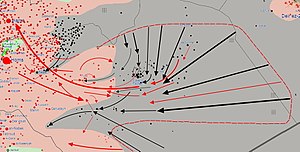Tadmur offensive (2015)
| Palmyra offensive (May 2015) | |||||||||
|---|---|---|---|---|---|---|---|---|---|
| Part of the Syrian Civil War | |||||||||
 Map of the territorial gains made by ISIL from 13–26 May, during the Palmyra offensive |
|||||||||
|
|||||||||
| Belligerents | |||||||||
|
|
|||||||||
| Commanders and leaders | |||||||||
|
|
|
||||||||
| Units involved | |||||||||
| Wilayat Homs | 18th Tank Battalion Suqur al-Sahara |
||||||||
| Strength | |||||||||
| 1,800–2,000+ (Palmyra city) | Unknown | ||||||||
| Casualties and losses | |||||||||
| 241–300 killed (SOHR claim) 170–200 killed (Syrian Army claim) |
150 killed (SOHR claim) 81 killed (Syrian Army claim) |
||||||||
| 71 civilians killed (49 executed by ISIL; 14–15 May) 168–280 government supporters and soldiers executed, and 600 detained (21–24 May) |
|||||||||
Major ISIL victory
![]() Abu Malik Anas Al-Nashwan †
Abu Malik Anas Al-Nashwan †![]() Abu Laith al-Saoudy
Abu Laith al-Saoudy
![]() Talal al-Barazi
Talal al-Barazi
(Governor of the Homs Governorate)
The Palmyra offensive of May 2015 was a military operation launched during the Syrian Civil War by the Islamic State of Iraq and the Levant (ISIL) on May 13-26, 2015, in an attempt to capture the government-held Tadmur District of the Homs Governorate, including the administrative centre of Tadmur, known in English as Palmyra. The ruins and ancient monuments of Palmyra, which lie on the south-western fringe of the modern city, have been a UNESCO World Heritage Site since 1980. The ruins were part of a desert oasis that was one of the most significant cultural centers of the ancient world, linking the civilizations of Persia, India, China with the Roman Empire through trade. The offensive was one of the largest offensives launched by ISIL, the largest one conducted by ISIL in Syria since the 2014 Eastern Syria offensive, with the result of the offensive increasing ISIL's control of Syria to at least 50%.
...
Wikipedia
